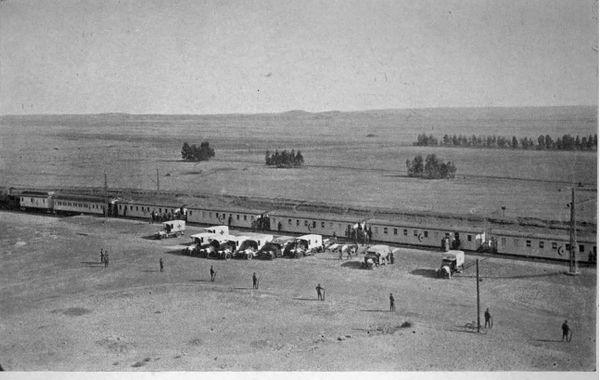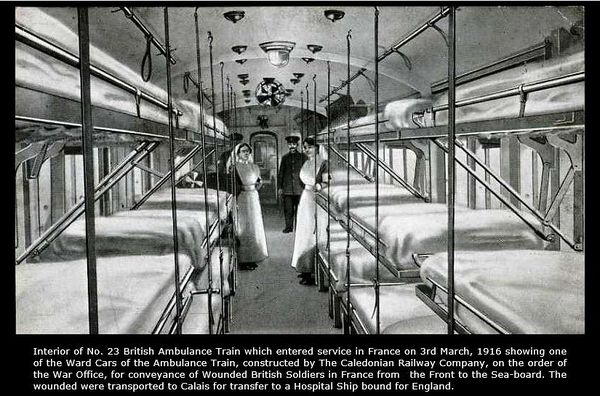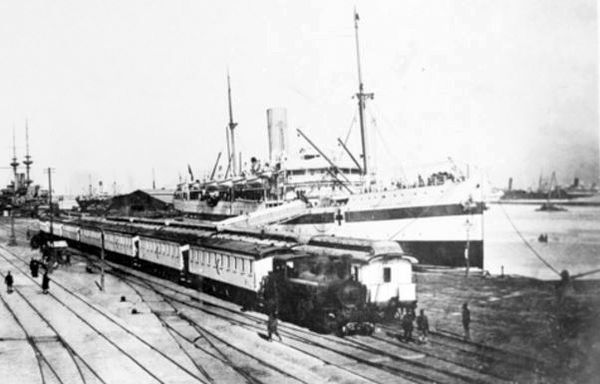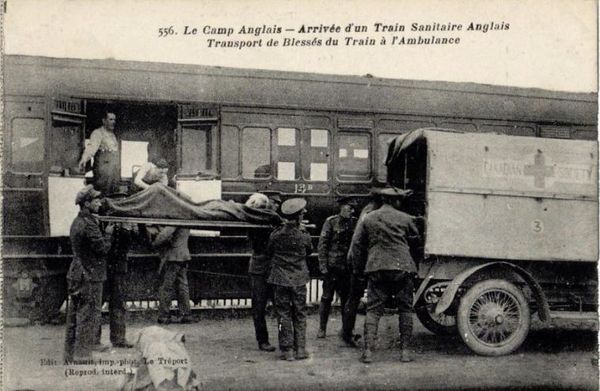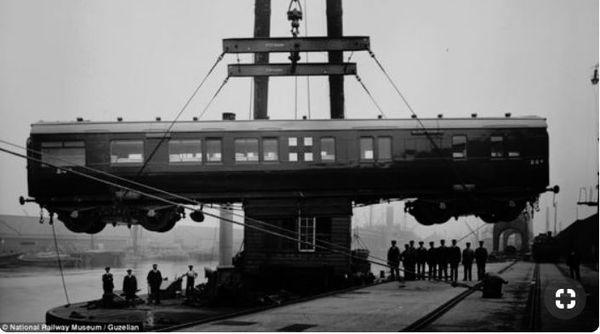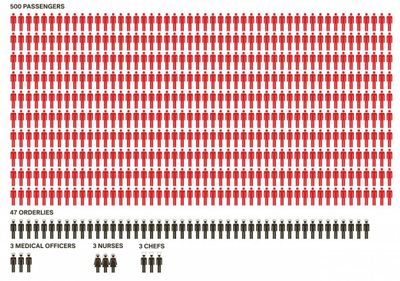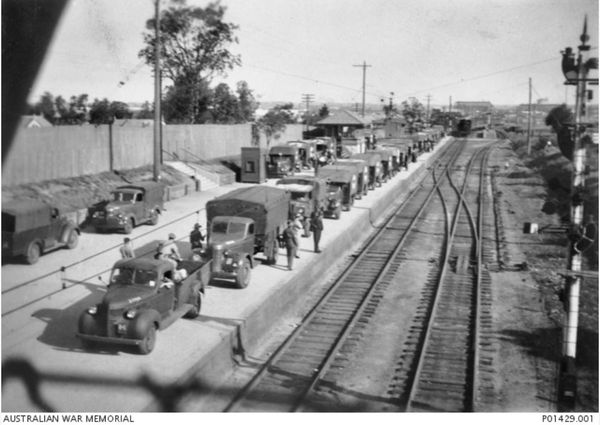Difference between revisions of "Ambulance Train"
From Our Contribution
(→Train Number not recorded) |
(→AT 28 ?? to Étaples) |
||
| (220 intermediate revisions by the same user not shown) | |||
| Line 8: | Line 8: | ||
| image2 = [[File:Hospital_train.jpg|600px]] | | image2 = [[File:Hospital_train.jpg|600px]] | ||
| caption2 = Hospital Train No 23 in France | | caption2 = Hospital Train No 23 in France | ||
| − | | image3 | + | | image3 = [[File:HMHS_Grantully_Castle_with_train.jpg|600px|]] |
| − | | caption3 | + | | caption3 = Ambulance train carrying patients to ships |
| + | | image4 = [[File:Ambulance_train_in_France.jpg|600px]] | ||
| + | | caption4 = Transfer casualty from train to ambulance in Tréport, France | ||
| + | | image5 = [[File:AT_being_loaded_for_France.jpg|600px]] | ||
| + | | caption5 = An Ambulance Train carriage being shipped to France | ||
| + | |||
| Line 22: | Line 27: | ||
Ambulance trains were used at various stages of medical evacuation from the front line to hospitals. They transported men away from battle as early as from advanced dressing stations. Light railways were used to transport soldiers to casualty clearing stations (CCS), which were deliberately built on railway lines for the movement of soldiers and medical supplies. Ambulance trains were then used again to move men from the CCS to base hospitals, and from the base hospitals to evacuation ports. | Ambulance trains were used at various stages of medical evacuation from the front line to hospitals. They transported men away from battle as early as from advanced dressing stations. Light railways were used to transport soldiers to casualty clearing stations (CCS), which were deliberately built on railway lines for the movement of soldiers and medical supplies. Ambulance trains were then used again to move men from the CCS to base hospitals, and from the base hospitals to evacuation ports. | ||
| − | |||
| − | The | + | The average load carried on a train was 400 to 500 patients, more than half of whom were quite helpless and a large number in a critical condition. Nurses from the trains, while waiting to load, would help at this C.C.S. The cases were exceedingly bad ones, brought there practically as they had been found on the field of battle. All that could be done for them at the C.C.S. was to dress their wounds and give them food. The patients taken on to the train were wearing full uniform in a shocking condition of filth. Owing to the cramped and difficult accommodation, it was almost impossible to undress the patients in the ordinary way, and consequently there was a great sacrifice of clothing. Where under normal conditions the clothes could have been removed and saved, for the sake of the patient they had to be cut away, and were of no further use. |
| + | |||
| + | |||
| + | The disposition of coaches on all the first Ambulance Trains was the same. One half of the train was set apart for what was known as ‘Lying cases’, and each compartment of the coach had 4 couchettes. In the middle of the train was the Dispensary, the coach for the Staff and the kitchens. The remaining portion of the train was ordinary 2nd or 3rd Class accommodation, where the so-called ‘walking cases’ were taken in. | ||
| + | |||
The Sisters’ quarters on the first 10 Ambulance Trains were in the Staff coach differing a little in position on each train. The arrangements on one of the trains, and one which on the whole was the best as regards the Sisters, was as follows:- At each end of the Staff coach was a separate compartment of 4 couchettes, divided off from the central compartments. These latter compartments were occupied by the 3 Medical Officers, and each of the end ones by two Sisters, so that they had the advantage of being quite private in their quarters. The one drawback was the lavatory accommodation which was in the middle of the coach. | The Sisters’ quarters on the first 10 Ambulance Trains were in the Staff coach differing a little in position on each train. The arrangements on one of the trains, and one which on the whole was the best as regards the Sisters, was as follows:- At each end of the Staff coach was a separate compartment of 4 couchettes, divided off from the central compartments. These latter compartments were occupied by the 3 Medical Officers, and each of the end ones by two Sisters, so that they had the advantage of being quite private in their quarters. The one drawback was the lavatory accommodation which was in the middle of the coach. | ||
| + | |||
The Restaurant car attached to the Staff coach was so divided that a part was used for the Mess Room, and the other part for the Dispensary. No.7 Ambulance Train was a little different from the others in that part was reserved for French troops. 4 coaches were given up to them, and there was a French Major and 6 orderlies, who were assisted by the British Sisters when necessary. | The Restaurant car attached to the Staff coach was so divided that a part was used for the Mess Room, and the other part for the Dispensary. No.7 Ambulance Train was a little different from the others in that part was reserved for French troops. 4 coaches were given up to them, and there was a French Major and 6 orderlies, who were assisted by the British Sisters when necessary. | ||
| + | |||
The Medical Staff consisted of 3 officers – the C.O., usually a Major, and two Lieutenants. The Nursing Staff of 4 on the train was usually distributed as follows. the Sister-in-Charge took the supervision of the whole train, was responsible for the Officers’ coach, and as much as possible helped where it was most needed. Two of the other Sisters were responsible for the ‘lying cases’ of other ranks, and the fourth was responsible for all the ‘sitting cases’. Two of the staff always remained on duty throughout the night, and frequently the whole four did so. | The Medical Staff consisted of 3 officers – the C.O., usually a Major, and two Lieutenants. The Nursing Staff of 4 on the train was usually distributed as follows. the Sister-in-Charge took the supervision of the whole train, was responsible for the Officers’ coach, and as much as possible helped where it was most needed. Two of the other Sisters were responsible for the ‘lying cases’ of other ranks, and the fourth was responsible for all the ‘sitting cases’. Two of the staff always remained on duty throughout the night, and frequently the whole four did so. | ||
| − | |||
| − | Their operation was the responsibility of the RAMC, and an RAMC Major was in charge of each train. | + | [[File:Ambulance_Train_2.jpg|thumb|none|400px|Normal patient - staff ratio]] |
| + | |||
| + | |||
| + | Generally the Ambulance trains carried casualties to hospitals near the French coast where they received further treatment before many that required extensive recovery were sent on to England. Once the men had arrived in Britain by ship, they were loaded onto the home ambulance trains that took them to hospital. Their operation was the responsibility of the RAMC, and an RAMC Major was in charge of each train. | ||
| + | |||
| + | |||
| + | [[File:Ambulance_Train.jpg|thumb|none|600px|Ambulances at an English station awaiting the arrival of an English Ambulance Train from Dover or Southampton | ||
| + | AWM photo P01429.001]] | ||
| − | |||
| − | By war's end 2.7 million men had used the Ambulance Trains. | + | Between journeys staff sometimes waited for days or even weeks for their next load of patients. A standard ambulance train consisted of sixteen cars, which included a pharmacy car, two kitchens, a personnel car, and a brake and stores car. The eleven patient cars would usually carry about 40 patients each, 36 bed patients and four seated. Most trains feeding ships for England did so in Boulogne, with the men being landed at Dover and Southampton. By war's end 2.7 million men had used the Ambulance Trains. |
| + | |||
| + | |||
| + | An article in Wikipedia states that thirty one Trains are known to have operated on the Continent with identifying numbers that include: 1, 2, 3, 4, 5, 6, 12, 16, 21, 23, 42, 49 and 71. Individual Records of the soldiers whose stories are included in this wiki include others, namely 15, 19, 20, 24, 25, 30, 31, 32, and 61. There were also 20 used in England with numbers that included: 14, and 34. Four of the trains were supplied and manned by Quakers and others with conscientious objection to taking lives. A detailed story of an Orderly crew member of AT17 in France can be found at [https://www.railwaymuseum.org.uk/objects-and-stories/ambulance-trains-bringing-first-world-war-home] | ||
| − | |||
==Staff== | ==Staff== | ||
| − | == | + | ==Patients carried== |
===Train Number not recorded=== | ===Train Number not recorded=== | ||
| − | |||
| − | |||
| − | + | ''Egypt & Palestine'' | |
| + | '''1916''' | ||
| + | * [[Henry Thomas (Harry) Brear]] 8 Apr 1916 | ||
| − | + | '''1917''' | |
| + | * [[Archibald Roland Bunney]] 1 Jun 1917 | ||
| + | * [[Walter Cattach]] 23 Jul 1917 | ||
| + | * [[Harold Shepherd MID]] 3 Aug 1917 | ||
| + | * [[Phillip Selwyn Allen]] 12 Oct 1917 to Rafa | ||
| + | * [[Phillip Selwyn Allen]] 14 Oct 1917 to El Arish | ||
| + | * [[George Ezra Bunney]] 16 Jan 1918 to El Arish | ||
| − | + | ''Western Front'' | |
| + | '''1916''' | ||
| + | * † [[Albert Edward John Walls]] 26 Jun 1916 & 9 Jun 1917 | ||
| + | * † [[Frederick James Bishop]] 19 - 20 Jul 1916 | ||
| + | * [[Walter Robert Hayes]] 22 Jul 1916 | ||
| + | * [[James Thomson MM]] 23 Jul 1916 | ||
| + | * [[William Joseph Hayden]] 26 Jul 1916 | ||
| + | * [[William Mathews]] 30 July 1916 | ||
| + | * [[Walter Hayward]] 5 Aug 1916 | ||
| + | * [[John Paterson Henderson]] 16 Aug 1916 | ||
| + | * [[Frank Halliday]] 29 Aug 1916 | ||
| + | * [[Lionel William Gibbs]] 5 Nov 1916 | ||
| + | * [[Roby Helliwell]] 15 Nov 1916 | ||
| + | * [[Maurice Clarence Robinson]] 23 Nov 1916 | ||
| + | * † [[Leonard Butcher]] 26 Dec 1916 | ||
| + | * † [[William Edgar Rowe]] 28 Dec 1916 | ||
| − | + | '''1917''' | |
| + | * [[Henry Richard Keefe]] 9 Jan 1917 | ||
| + | * † [[Francis Dyson]] 31 Jan 1917 | ||
| + | * [[William Edward McKenna]] 8 Feb 1917 | ||
| + | * † [[Gordon Weston Johanson]] 19 Feb 1917 | ||
| + | * [[Donald Gordon Melville Huggins]] 21 Feb 1917 | ||
| + | * [[Leo Patrick Kane]] 13 Mar 1917 | ||
| + | * † [[Albert Edward See]] 19 Mar 1917 | ||
| + | * † [[Albert Ernest Elkington]] 22 Mar 1918 | ||
| + | * [[George Harris]] 6 Apr 1917 | ||
| + | * [[Edward Hobson]] 12 Apr 1917 | ||
| + | * † [[Frederick James Powell]] 20 Apr 1917 | ||
| + | * † [[Reuben Arnold MM]] 24 Apr 1917 | ||
| + | * [[Ernest Henry Chisholm]] 4 May 1917 | ||
| + | * † [[John Hobbs]] 4 May 1917 | ||
| + | * [[Walter Hayward]] 5-6 May 1917 | ||
| + | * [[George Bett]] 14 May 1917 | ||
| + | * [[Francis William Singleton]] 15 May 1917 | ||
| + | * [[Alexander Dowle]] 5 Jun 1917 | ||
| + | * [[Reginald Grove Sexty MID]] 8 Jun 1917 | ||
| + | * [[Thomas Frederick McDonough]] 10 Jun 1917 | ||
| + | * [[Henry Albert Thorp]] 12 Jun 1917 | ||
| + | * [[Arthur Percy Thomas Boyle]] 16 Jun 1917 | ||
| + | * † [[David Edward Bromley]] 18 Jun 1917 | ||
| + | * † [[Albert Edward John Walls]] 26 Jun 1917 & 9 Jun 1917 | ||
| + | * [[Gordon Edgar (George) Bennett]] 4 Jul 1917 | ||
| + | * [[Herbert James Reed]] 27 Jul 1917 | ||
| + | * [[John Arthur Patterson MM]] 2 Aug 1917 | ||
| + | * [[William George Rosekelly]] 20 Sep 1917 | ||
| + | * † [[David Edward Bromley]] 21 Sep 1917 | ||
| + | * [[John Edward Thomson]] 29 Sep 1917 | ||
| + | * [[Josiah James Skinner]] 1 Oct 1917 | ||
| + | * [[Robert George Orrock]] 2 Oct 1917 | ||
| + | * [[David Forbes Abernethy]] 4 Oct 1917 | ||
| + | * † [[Reuben Arnold MM]] 4 Oct 1917 | ||
| + | * [[Arthur Percy Thomas Boyle]] 1 Nov 1917 | ||
| + | * [[Stanley Victor Coney]] 15 Nov 1917 | ||
| − | + | '''1918''' | |
| + | * [[Alfred James Hansen MM]] 5 Feb 1918 | ||
| + | * [[Thomas Hesketh]] 5 Feb 1918 | ||
| + | * † [[Albert Ernest Elkington]] 22 Mar 1918 | ||
| + | * [[Jack Hayden Gibson]] 29 Mar 1918 | ||
| + | * [[George Weston Firns]] 19 Apr 1918 | ||
| + | * [[David Forbes Abernethy]] 2 Jun 1918 | ||
| + | * [[Gordon Edgar (George) Bennett]] 2 Jun 1918 | ||
| + | * [[Norman Sedrick Tonkin]] 9 Jun 1918 | ||
| + | * [[Arthur James Allen]] 14 Jun 1918 | ||
| + | * [[ William Henry Gibbs]] 14 July 1918 | ||
| + | * [[John Edward Thomson]] 9 Aug 1918 | ||
| + | * [[John Grant Watt MM & Bar]] 25 Aug 1918 ? | ||
| + | * [[John Kiely]] 28 Aug 1918 | ||
| + | * [[Charles Glyn Firns]] 3 Sep 1918 | ||
| + | * [[Thomas Percival (Percy) Hanretty]] 3 Sep 1918 | ||
| + | * [[Walter Hayward]] 5 Sep 1918 | ||
| + | * [[Reginald William Edwards]] 6 - 7 Oct 1918 | ||
| + | * [[George Alfred Hill]] 14 Oct 1918 | ||
| + | * [[George Weston Firns]] 16 Oct 1918 | ||
| − | + | '''Australia during WW2''' | |
| + | * [[James Henry Clarke]] 27 - 28 Jan 1944 Brisbane to Melbourne | ||
| + | * [[James Henry Clarke]] 12 - 16 Feb 1944 Melbourne to Perth | ||
| − | === | + | ===AT 1=== |
| + | *[[Ernest James Brandon Bettenay]] 24 Apr 1919 | ||
| − | === | + | ===AT 2=== |
| + | *[[William James Allen]] 18 May 1918 | ||
| + | * [[William Rawlinson]] 19 Jul 1918 | ||
| + | |||
| + | ===AT 3=== | ||
| + | ?? to Camiers | ||
| + | *[[Charles Richard Irvine MM & Bar]] 7 Nov 1916 | ||
| + | |||
| + | ===AT 4 Egypt Tel-el-Kebir to Ghezireh=== | ||
| + | * [[John Harold Rupert Smith]] 7 Feb 1916 | ||
| + | * [[Douglas Campbell Wills Winning]] 26 Mar 1916 | ||
| + | * [[William Buck]] 27 Apr 1916 | ||
| + | |||
| + | ===AT 4 France=== | ||
| + | * [[John Harold Coffen]] 6 May 1917 | ||
| + | |||
| + | ===AT 5=== | ||
| + | * [[William Plant]] 8 Dec 1916 | ||
| + | * [[Joseph Pulford]] 9 Feb 1917 | ||
| + | * [[Nicholas Joseph Rosekelly]] 17 Nov 1917 | ||
| + | |||
| + | ===AT 6=== | ||
| + | * [[William Arthur Shepherd]] 1 May 1916 | ||
| + | * [[Clarence Henry Batt]] 22 Dec 1918 | ||
| + | |||
| + | ===AT 7 ?? to Boulogne === | ||
| + | |||
| + | * [[Percy Fleming]] 10 Jul 1917 | ||
| + | * [[William Isaac Little]] 4 Jul 1918 | ||
| + | |||
| + | ===AT 8=== | ||
| + | *[[Charles John Mitchell]] 11 Jun 1918 | ||
| + | |||
| + | ===AT 9=== | ||
| + | *[[Harry Simpson Francis]] 5 Jull 1918 | ||
| + | |||
| + | ===AT 10 ?? to Boulogne=== | ||
| + | |||
| + | * † [[David Alexander Sayer]] 20 Sep 1917 | ||
| + | |||
| + | ===AT 11=== | ||
| + | * [[John Aubrey Nunn MC]] 1 - 2 Sep 1918 | ||
| + | |||
| + | ===AT 12 ?? to Abbeyville=== | ||
| + | |||
| + | * [[Lyndon Vivian Brady]] 9 Dec 1916 | ||
| + | * † [[Arthur Thomas Feast]] 19 Jul 917 | ||
| + | *[[Thomas Hale Kensit]] 20 Mar 1918 | ||
| + | |||
| + | ===AT 14=== | ||
*[[Albert Edward Victor Byfield]] 22 Sep 1917 | *[[Albert Edward Victor Byfield]] 22 Sep 1917 | ||
| + | *[[Sydney Chadwick McDonald]] 17 Nov 1918 | ||
| + | *[[William Thomas Driver]] 30 Mar 1919 | ||
| − | === | + | ===AT 15 Transferred patients to Rouen=== |
| + | Donated by Princess Christian. | ||
| + | * [[William Stephens]] 21 Aug 1916 | ||
| + | * [[Lancel Butcher]] 29 Jul 1917 | ||
| + | * [[William Wright Casterton MM]] 5 Jul 1918 | ||
| + | * [[Thomas Hetherington]] 1 Sep 1918 | ||
| + | * [[Harold Empsall]] 13 - 14 Mar 1919 | ||
| + | |||
| + | ===AT 16=== | ||
| + | Donated by the United Kingdom Flour Millers | ||
*[[James Baillie]] 3 May 1917 | *[[James Baillie]] 3 May 1917 | ||
| + | * [[Lennart Birger Wilander]] 21 Aug 1918 | ||
| + | |||
| + | ===AT 18=== | ||
| + | *[[Percy Goodall]] 22 July 1916 | ||
| + | |||
| + | ===AT 19=== | ||
| + | * [[Arthur Leworthy Bettenay]] 8 Jun 1917 | ||
| + | * [[James Baillie]] 9 Aug 1918 | ||
| + | * [[Arthur Frederick William Eivers]] 16 Sep 1918 | ||
| + | |||
| + | ===AT 20=== | ||
| + | * [[William Harrington Edward Watson]] 23 - 24 May 1916 | ||
| + | * [[Edgar Leslie Livermore]] 25 Jul 1916 | ||
| + | *[[Leith John Newton Angelo]] 19 Oct 1917 | ||
| + | *[[Sydney Chadwick McDonald]] 21 Oct 1917 | ||
| + | |||
| + | ===AT 21=== | ||
| + | * [[Michael Dennis O'Rourke]] 8 May 1917 | ||
| + | |||
| + | ===AT 22=== | ||
| + | * [[George William Piesley]] 7 Jul 1917 | ||
| + | |||
| + | ===AT 23 ?? to Le Havre=== | ||
| + | |||
| + | * [[John Harold Rupert Smith]] 12 Nov 1916 | ||
| + | * [[John Thomas Clements]] 7 & 8 Oct 1918 | ||
| + | |||
| + | ===AT 24=== | ||
| + | * [[Cyril Lowth MM]] 24 Nov 1916 | ||
| + | *[[Leith John Newton Angelo]] 9 Aug 1918 | ||
| + | |||
| + | ===AT 25=== | ||
| + | * [[Herbert Clarence (Bert) Ronan]] 28 Mar 1917 | ||
| + | * [[Matthew Walsh]] 18 Apr 1918 | ||
| + | * [[William James Allen]] 3 Mar 1919 | ||
| + | |||
| + | ===AT 26 to Boulogne=== | ||
| + | * † [[Samuel Simpson Thompson]] 30 Jul 1916 | ||
| + | * [[Arthur Thomas Orton MM]] 28 Mar 1918 | ||
| + | |||
| + | ===AT 27 ?? to Rouen=== | ||
| + | |||
| + | * [[Alfred Warburton Chapman (Jnr)]] 23 Jul 1916 | ||
| + | * [[Charles Gorringe]] 6 Nov 1916 | ||
| + | |||
| + | ===AT 28 ?? to Étaples=== | ||
| + | |||
| + | *[[Jack Hayden Gibson]] 31 Aug 1916 | ||
| + | *[[William John (Bill) Hart]] 30 Aug 1916 | ||
| + | *[[Edward Dudley Mann]] 10 May 1917 | ||
| + | * [[Robert Lightbody]] 16 Mar 1918 | ||
| + | |||
| + | ===AT 29 ? to Camiers=== | ||
| − | + | * [[John Laidlaw Paterson]] 11 Aug 1918 | |
| − | === | + | ===AT 30=== |
| + | * † [[Beverley Loxton Bennett]] 9 Jul 1918 | ||
| − | === | + | ===AT 31=== |
| + | *[[George Henry Aspinall]] 6 Jun 1917 | ||
| − | === | + | ===AT 32 ?? to Boulogne=== |
| − | === | + | * [[Edward Bailey]] 14 Apr 1918 |
| + | * † [[David Alexander Sayer]] 5 May 1918 | ||
| + | * [[Roslyn Christopher Coulston]] 17 May 1918 | ||
| + | * † [[Daniel Malcolm Wann]] 21 Jun 1918 | ||
| + | |||
| + | ===AT 33=== | ||
| + | * [[William Plant]] 27 Feb 1919 | ||
| + | |||
| + | ===AT 34=== | ||
| + | * [[John Harold Coffen]] 5 Mar 1918 | ||
| + | *[[Thomas Hale Kensit]] 8 Aug 1918 | ||
| + | * [[Ernest Ball DCM]] 26 Aug 1918 | ||
| + | |||
| + | ===AT 35=== | ||
| + | * [[John Arthur Patterson MM]] 7 Jul 1918 | ||
| + | |||
| + | ===At 36=== | ||
| + | * [[John Alexander Spilsbury]] 20 Sep 1917 | ||
| + | * [[James Anthony Parker]] 22 Oct 1917 | ||
| + | *[[Frank Moore]] 3 Nov 1917 | ||
| + | |||
| + | ===AT 42=== | ||
| + | * [[John Henry Holroyd]] 3 Apr 1917 | ||
| + | * [[William Henry Gibbs]] 25 Sep 1918 | ||
| + | * [[Sydney Scott]] 3 Jan 1919 | ||
| + | * [[Lancel Butcher]] 6 Jan 1919 | ||
| + | |||
| + | ===AT 47 ?? to Boulogne=== | ||
| + | |||
| + | * [[Matthew Harwood]] 12 Aug 1916 | ||
| + | |||
| + | ===AT 61 ?? To Rouen=== | ||
| + | |||
| + | *[[Robert Frank Bickford]] 27 Jun 1918 | ||
==Notes== | ==Notes== | ||
| Line 86: | Line 330: | ||
==External Links== | ==External Links== | ||
| − | + | [[Category:AIF Units]] | |
[[Category:Hospitals]] | [[Category:Hospitals]] | ||
Latest revision as of 20:29, 1 November 2023
Contents
- 1 Remarks
- 2 Staff
- 3 Patients carried
- 3.1 Train Number not recorded
- 3.2 AT 1
- 3.3 AT 2
- 3.4 AT 3
- 3.5 AT 4 Egypt Tel-el-Kebir to Ghezireh
- 3.6 AT 4 France
- 3.7 AT 5
- 3.8 AT 6
- 3.9 AT 7 ?? to Boulogne
- 3.10 AT 8
- 3.11 AT 9
- 3.12 AT 10 ?? to Boulogne
- 3.13 AT 11
- 3.14 AT 12 ?? to Abbeyville
- 3.15 AT 14
- 3.16 AT 15 Transferred patients to Rouen
- 3.17 AT 16
- 3.18 AT 18
- 3.19 AT 19
- 3.20 AT 20
- 3.21 AT 21
- 3.22 AT 22
- 3.23 AT 23 ?? to Le Havre
- 3.24 AT 24
- 3.25 AT 25
- 3.26 AT 26 to Boulogne
- 3.27 AT 27 ?? to Rouen
- 3.28 AT 28 ?? to Étaples
- 3.29 AT 29 ? to Camiers
- 3.30 AT 30
- 3.31 AT 31
- 3.32 AT 32 ?? to Boulogne
- 3.33 AT 33
- 3.34 AT 34
- 3.35 AT 35
- 3.36 At 36
- 3.37 AT 42
- 3.38 AT 47 ?? to Boulogne
- 3.39 AT 61 ?? To Rouen
- 4 Notes
- 5 External Links
Remarks
Ambulance trains were used at various stages of medical evacuation from the front line to hospitals. They transported men away from battle as early as from advanced dressing stations. Light railways were used to transport soldiers to casualty clearing stations (CCS), which were deliberately built on railway lines for the movement of soldiers and medical supplies. Ambulance trains were then used again to move men from the CCS to base hospitals, and from the base hospitals to evacuation ports.
The average load carried on a train was 400 to 500 patients, more than half of whom were quite helpless and a large number in a critical condition. Nurses from the trains, while waiting to load, would help at this C.C.S. The cases were exceedingly bad ones, brought there practically as they had been found on the field of battle. All that could be done for them at the C.C.S. was to dress their wounds and give them food. The patients taken on to the train were wearing full uniform in a shocking condition of filth. Owing to the cramped and difficult accommodation, it was almost impossible to undress the patients in the ordinary way, and consequently there was a great sacrifice of clothing. Where under normal conditions the clothes could have been removed and saved, for the sake of the patient they had to be cut away, and were of no further use.
The disposition of coaches on all the first Ambulance Trains was the same. One half of the train was set apart for what was known as ‘Lying cases’, and each compartment of the coach had 4 couchettes. In the middle of the train was the Dispensary, the coach for the Staff and the kitchens. The remaining portion of the train was ordinary 2nd or 3rd Class accommodation, where the so-called ‘walking cases’ were taken in.
The Sisters’ quarters on the first 10 Ambulance Trains were in the Staff coach differing a little in position on each train. The arrangements on one of the trains, and one which on the whole was the best as regards the Sisters, was as follows:- At each end of the Staff coach was a separate compartment of 4 couchettes, divided off from the central compartments. These latter compartments were occupied by the 3 Medical Officers, and each of the end ones by two Sisters, so that they had the advantage of being quite private in their quarters. The one drawback was the lavatory accommodation which was in the middle of the coach.
The Restaurant car attached to the Staff coach was so divided that a part was used for the Mess Room, and the other part for the Dispensary. No.7 Ambulance Train was a little different from the others in that part was reserved for French troops. 4 coaches were given up to them, and there was a French Major and 6 orderlies, who were assisted by the British Sisters when necessary.
The Medical Staff consisted of 3 officers – the C.O., usually a Major, and two Lieutenants. The Nursing Staff of 4 on the train was usually distributed as follows. the Sister-in-Charge took the supervision of the whole train, was responsible for the Officers’ coach, and as much as possible helped where it was most needed. Two of the other Sisters were responsible for the ‘lying cases’ of other ranks, and the fourth was responsible for all the ‘sitting cases’. Two of the staff always remained on duty throughout the night, and frequently the whole four did so.
Generally the Ambulance trains carried casualties to hospitals near the French coast where they received further treatment before many that required extensive recovery were sent on to England. Once the men had arrived in Britain by ship, they were loaded onto the home ambulance trains that took them to hospital. Their operation was the responsibility of the RAMC, and an RAMC Major was in charge of each train.
Between journeys staff sometimes waited for days or even weeks for their next load of patients. A standard ambulance train consisted of sixteen cars, which included a pharmacy car, two kitchens, a personnel car, and a brake and stores car. The eleven patient cars would usually carry about 40 patients each, 36 bed patients and four seated. Most trains feeding ships for England did so in Boulogne, with the men being landed at Dover and Southampton. By war's end 2.7 million men had used the Ambulance Trains.
An article in Wikipedia states that thirty one Trains are known to have operated on the Continent with identifying numbers that include: 1, 2, 3, 4, 5, 6, 12, 16, 21, 23, 42, 49 and 71. Individual Records of the soldiers whose stories are included in this wiki include others, namely 15, 19, 20, 24, 25, 30, 31, 32, and 61. There were also 20 used in England with numbers that included: 14, and 34. Four of the trains were supplied and manned by Quakers and others with conscientious objection to taking lives. A detailed story of an Orderly crew member of AT17 in France can be found at [1]
Staff
Patients carried
Train Number not recorded
Egypt & Palestine 1916
- Henry Thomas (Harry) Brear 8 Apr 1916
1917
- Archibald Roland Bunney 1 Jun 1917
- Walter Cattach 23 Jul 1917
- Harold Shepherd MID 3 Aug 1917
- Phillip Selwyn Allen 12 Oct 1917 to Rafa
- Phillip Selwyn Allen 14 Oct 1917 to El Arish
- George Ezra Bunney 16 Jan 1918 to El Arish
Western Front 1916
- † Albert Edward John Walls 26 Jun 1916 & 9 Jun 1917
- † Frederick James Bishop 19 - 20 Jul 1916
- Walter Robert Hayes 22 Jul 1916
- James Thomson MM 23 Jul 1916
- William Joseph Hayden 26 Jul 1916
- William Mathews 30 July 1916
- Walter Hayward 5 Aug 1916
- John Paterson Henderson 16 Aug 1916
- Frank Halliday 29 Aug 1916
- Lionel William Gibbs 5 Nov 1916
- Roby Helliwell 15 Nov 1916
- Maurice Clarence Robinson 23 Nov 1916
- † Leonard Butcher 26 Dec 1916
- † William Edgar Rowe 28 Dec 1916
1917
- Henry Richard Keefe 9 Jan 1917
- † Francis Dyson 31 Jan 1917
- William Edward McKenna 8 Feb 1917
- † Gordon Weston Johanson 19 Feb 1917
- Donald Gordon Melville Huggins 21 Feb 1917
- Leo Patrick Kane 13 Mar 1917
- † Albert Edward See 19 Mar 1917
- † Albert Ernest Elkington 22 Mar 1918
- George Harris 6 Apr 1917
- Edward Hobson 12 Apr 1917
- † Frederick James Powell 20 Apr 1917
- † Reuben Arnold MM 24 Apr 1917
- Ernest Henry Chisholm 4 May 1917
- † John Hobbs 4 May 1917
- Walter Hayward 5-6 May 1917
- George Bett 14 May 1917
- Francis William Singleton 15 May 1917
- Alexander Dowle 5 Jun 1917
- Reginald Grove Sexty MID 8 Jun 1917
- Thomas Frederick McDonough 10 Jun 1917
- Henry Albert Thorp 12 Jun 1917
- Arthur Percy Thomas Boyle 16 Jun 1917
- † David Edward Bromley 18 Jun 1917
- † Albert Edward John Walls 26 Jun 1917 & 9 Jun 1917
- Gordon Edgar (George) Bennett 4 Jul 1917
- Herbert James Reed 27 Jul 1917
- John Arthur Patterson MM 2 Aug 1917
- William George Rosekelly 20 Sep 1917
- † David Edward Bromley 21 Sep 1917
- John Edward Thomson 29 Sep 1917
- Josiah James Skinner 1 Oct 1917
- Robert George Orrock 2 Oct 1917
- David Forbes Abernethy 4 Oct 1917
- † Reuben Arnold MM 4 Oct 1917
- Arthur Percy Thomas Boyle 1 Nov 1917
- Stanley Victor Coney 15 Nov 1917
1918
- Alfred James Hansen MM 5 Feb 1918
- Thomas Hesketh 5 Feb 1918
- † Albert Ernest Elkington 22 Mar 1918
- Jack Hayden Gibson 29 Mar 1918
- George Weston Firns 19 Apr 1918
- David Forbes Abernethy 2 Jun 1918
- Gordon Edgar (George) Bennett 2 Jun 1918
- Norman Sedrick Tonkin 9 Jun 1918
- Arthur James Allen 14 Jun 1918
- William Henry Gibbs 14 July 1918
- John Edward Thomson 9 Aug 1918
- John Grant Watt MM & Bar 25 Aug 1918 ?
- John Kiely 28 Aug 1918
- Charles Glyn Firns 3 Sep 1918
- Thomas Percival (Percy) Hanretty 3 Sep 1918
- Walter Hayward 5 Sep 1918
- Reginald William Edwards 6 - 7 Oct 1918
- George Alfred Hill 14 Oct 1918
- George Weston Firns 16 Oct 1918
Australia during WW2
- James Henry Clarke 27 - 28 Jan 1944 Brisbane to Melbourne
- James Henry Clarke 12 - 16 Feb 1944 Melbourne to Perth
AT 1
- Ernest James Brandon Bettenay 24 Apr 1919
AT 2
- William James Allen 18 May 1918
- William Rawlinson 19 Jul 1918
AT 3
?? to Camiers
- Charles Richard Irvine MM & Bar 7 Nov 1916
AT 4 Egypt Tel-el-Kebir to Ghezireh
- John Harold Rupert Smith 7 Feb 1916
- Douglas Campbell Wills Winning 26 Mar 1916
- William Buck 27 Apr 1916
AT 4 France
- John Harold Coffen 6 May 1917
AT 5
- William Plant 8 Dec 1916
- Joseph Pulford 9 Feb 1917
- Nicholas Joseph Rosekelly 17 Nov 1917
AT 6
- William Arthur Shepherd 1 May 1916
- Clarence Henry Batt 22 Dec 1918
AT 7 ?? to Boulogne
- Percy Fleming 10 Jul 1917
- William Isaac Little 4 Jul 1918
AT 8
- Charles John Mitchell 11 Jun 1918
AT 9
- Harry Simpson Francis 5 Jull 1918
AT 10 ?? to Boulogne
- † David Alexander Sayer 20 Sep 1917
AT 11
- John Aubrey Nunn MC 1 - 2 Sep 1918
AT 12 ?? to Abbeyville
- Lyndon Vivian Brady 9 Dec 1916
- † Arthur Thomas Feast 19 Jul 917
- Thomas Hale Kensit 20 Mar 1918
AT 14
- Albert Edward Victor Byfield 22 Sep 1917
- Sydney Chadwick McDonald 17 Nov 1918
- William Thomas Driver 30 Mar 1919
AT 15 Transferred patients to Rouen
Donated by Princess Christian.
- William Stephens 21 Aug 1916
- Lancel Butcher 29 Jul 1917
- William Wright Casterton MM 5 Jul 1918
- Thomas Hetherington 1 Sep 1918
- Harold Empsall 13 - 14 Mar 1919
AT 16
Donated by the United Kingdom Flour Millers
- James Baillie 3 May 1917
- Lennart Birger Wilander 21 Aug 1918
AT 18
- Percy Goodall 22 July 1916
AT 19
- Arthur Leworthy Bettenay 8 Jun 1917
- James Baillie 9 Aug 1918
- Arthur Frederick William Eivers 16 Sep 1918
AT 20
- William Harrington Edward Watson 23 - 24 May 1916
- Edgar Leslie Livermore 25 Jul 1916
- Leith John Newton Angelo 19 Oct 1917
- Sydney Chadwick McDonald 21 Oct 1917
AT 21
- Michael Dennis O'Rourke 8 May 1917
AT 22
- George William Piesley 7 Jul 1917
AT 23 ?? to Le Havre
- John Harold Rupert Smith 12 Nov 1916
- John Thomas Clements 7 & 8 Oct 1918
AT 24
- Cyril Lowth MM 24 Nov 1916
- Leith John Newton Angelo 9 Aug 1918
AT 25
- Herbert Clarence (Bert) Ronan 28 Mar 1917
- Matthew Walsh 18 Apr 1918
- William James Allen 3 Mar 1919
AT 26 to Boulogne
- † Samuel Simpson Thompson 30 Jul 1916
- Arthur Thomas Orton MM 28 Mar 1918
AT 27 ?? to Rouen
- Alfred Warburton Chapman (Jnr) 23 Jul 1916
- Charles Gorringe 6 Nov 1916
AT 28 ?? to Étaples
- Jack Hayden Gibson 31 Aug 1916
- William John (Bill) Hart 30 Aug 1916
- Edward Dudley Mann 10 May 1917
- Robert Lightbody 16 Mar 1918
AT 29 ? to Camiers
- John Laidlaw Paterson 11 Aug 1918
AT 30
- † Beverley Loxton Bennett 9 Jul 1918
AT 31
- George Henry Aspinall 6 Jun 1917
AT 32 ?? to Boulogne
- Edward Bailey 14 Apr 1918
- † David Alexander Sayer 5 May 1918
- Roslyn Christopher Coulston 17 May 1918
- † Daniel Malcolm Wann 21 Jun 1918
AT 33
- William Plant 27 Feb 1919
AT 34
- John Harold Coffen 5 Mar 1918
- Thomas Hale Kensit 8 Aug 1918
- Ernest Ball DCM 26 Aug 1918
AT 35
- John Arthur Patterson MM 7 Jul 1918
At 36
- John Alexander Spilsbury 20 Sep 1917
- James Anthony Parker 22 Oct 1917
- Frank Moore 3 Nov 1917
AT 42
- John Henry Holroyd 3 Apr 1917
- William Henry Gibbs 25 Sep 1918
- Sydney Scott 3 Jan 1919
- Lancel Butcher 6 Jan 1919
AT 47 ?? to Boulogne
- Matthew Harwood 12 Aug 1916
AT 61 ?? To Rouen
- Robert Frank Bickford 27 Jun 1918
Notes
